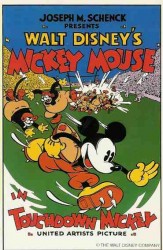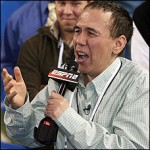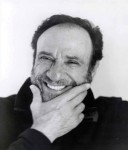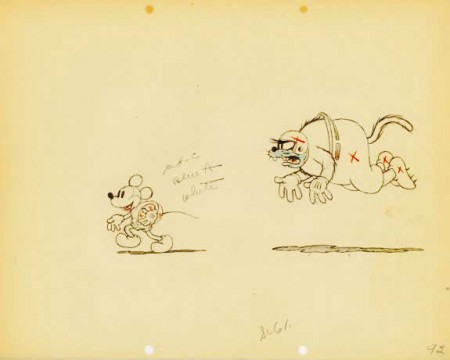SpornFilms &Story & Storyboards 21 Mar 2007 08:00 am
Story (board)
 – With all this presentation of storyboards and storyboard documents, it was a real find to come upon the document Didier Ghez posted on his site, Disney History. It’s a story outline from Walt, himself, for the 1932 short Touchdown Mickey. The telling piece comes from the collection of Mark Sonntag.
– With all this presentation of storyboards and storyboard documents, it was a real find to come upon the document Didier Ghez posted on his site, Disney History. It’s a story outline from Walt, himself, for the 1932 short Touchdown Mickey. The telling piece comes from the collection of Mark Sonntag.
Obviously, there was something of a real give-and-take in the Disney films re script vs storyboard creation. Thanks to Merritt & Kaufman’s Walt In Wonderland, we saw documents like this for the silent shorts. However, I don’t remember too many treatments published for the sound shorts.
Of course, if this is the case for the short films, it’s obvious that more elaborate treatments were done for the features.
Oddly, this resembles the “scripts” written for the Larry David Show. On the set of that show the actors improvise dialogue around the breakdowns Larry David writes. The improvisation develops on its own and is pared down or built up in the editing of the final films.
 We did something like this in the making of The Little Match Girl. We’d hired Gilbert Gottfried in 1989 – long before Aladdin – to improvise the narration track in the recording studio. My writer, Maxine Fisher, had to write a one-page treatment of the Anderson tale for Gilbert to take into the recording booth. He read the treatment and kept elaborating on it making a lot of jokes as he read.
We did something like this in the making of The Little Match Girl. We’d hired Gilbert Gottfried in 1989 – long before Aladdin – to improvise the narration track in the recording studio. My writer, Maxine Fisher, had to write a one-page treatment of the Anderson tale for Gilbert to take into the recording booth. He read the treatment and kept elaborating on it making a lot of jokes as he read.
The full track was cut down to the half-hour format, and we storyboarded that. Adjusting. Adjusting Adjusting. (Gilbert Gottfried)
.
 Eventually, the overseas distributor, the video client, and HBO all asked us to get rid of the angry, yelling voice. They were financing it, so I had to, sadly, alter the track. It became a massive job since the cadences of Gottfried were so different from anyone else. 1/3 of the animation had been completed, and a lot of changes had to happen.
Eventually, the overseas distributor, the video client, and HBO all asked us to get rid of the angry, yelling voice. They were financing it, so I had to, sadly, alter the track. It became a massive job since the cadences of Gottfried were so different from anyone else. 1/3 of the animation had been completed, and a lot of changes had to happen.
We wrote a script from the old storyboard, including some of Gilbert’s jokes, and F. Murray Abraham did a great job of acting out the new narration.
(F. Murray Abraham)
In the end, I had a bit of difficulty watching the film again. It had taken so many turns. Sheila Nevins, the chief at HBO, asked me six months later if I thought this my best film. She loved it so much. I had to watch the movie again to think about it.
Stuff happens.
Sorry for that riff, but I guess this story is on my mind since we’re releasing the dvd of The Little Match Girl in companionship with The Red Shoes this coming June. We’ve been making “The Making ofs … ” for the past couple of months, and I’ve been thinking about it.
I still do think a lot about the script/storyboard/script methodology and have seen a lot of variations. I couldn’t help but point one out. I also have a lot more to say on the subject, but I’ll hold off for another time. I have a UPA storyboard by T.Hee I want to show you.

It’s interesting that I own a 16mm copy of Touchdown Mickey as well as the dvd, of course. I’ve seen the short many times and like it, but I have a lot of other B&W ones I like more. Now if it were Baseball Mickey I might feel differently.


on 21 Mar 2007 at 12:58 pm 1.Stephen Worth said …
That’s an outline, not a script. The process at just about every studio was the same…
1) Premise: A one or two sentence idea for the theme of a cartoon
2) Story Meeting (sometimes called a “No No Session”): The artists would get together and brainstorm ideas on the theme. The ideas didn’t have to make any kind of plot sense, just random ideas. These would be thumbnailed and gathered together with transcripts of the story meeting.
3) The notes and doodles from the story meeting would be organized by the director into an outline indicating the basic continuity of the story- beginning, middle and end. Each of the points in the outline would refer back to specific notes and thumbnail doodles from the story meeting.
4) When the outline was approved, it would be given to the storyboard artist to board from, along with all the thumbnail sketches that correspond to the various points. He would work sequence by sequence through the outline making the ideas read visually.
This is entirely different than the process of scriptwriting used in animation today. In the current system, a writer comes up with the premise and outline with the network, independent of the artists. Then he writes a script detailing all the action and dialogue in words. This script is network apprved, and the storyboard artist is told he can’t deviate from the script. Not being an artist, a writer can’t know how action is going to work visually. So he leans on dialogue to carry the exposition instead of visual storytelling.
In the first process, the artists are free to develop the story visually through drawings. In the modern way, the artist has very little input. He is just illustrating the writer’s ideas which are locked in stone before he gets the story to board.
See ya
Steve
on 21 Mar 2007 at 3:46 pm 2.Michael said …
You’ll note that I said it was a “story outline” not a script. This is more than one or two sentences. One wouldn’t expect Walt to have written a script for a short. A “story outline” is enough to build an episode of one of Larry David’s shows; it should be enough to build a short.
on 22 Mar 2007 at 7:45 am 3.Stephen said …
In regards to “The Little Match Girl”. Do you still have the animation that was done for Gilbert Gottfried naration? if so maybe it can be added to the new release.
on 22 Mar 2007 at 8:02 am 4.Michael said …
We did search for the VO tracks for the Gottfried recording and were hoping to include some of it on the dvd. However, when we moved to this newer location, it was probably buried somewhere in storage (if not discarded unintentionally), and we haven’t been able to locate it without a lot of expense. So, it’s not going to make it to the dvd.
We will include part of the animatic that was done for the films.
Stephen was the guy who hand colored most of The Little Match Girl and The Red Shoes.